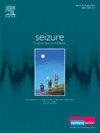Neurodevelopmental milestone acquisition following early hemispherotomy in Sturge-Weber syndrome
IF 2.8
3区 医学
Q2 CLINICAL NEUROLOGY
引用次数: 0
Abstract
Purpose
To investigate the influence of clinical factors on the acquisition of neurodevelopmental milestones in patients with Sturge-Weber syndrome (SWS) who underwent hemispherotomy.
Methods
We retrospectively analyzed 34 patients with SWS who underwent hemispherotomy at the Epilepsy Center of Juntendo University Hospital between 2006 and 2022. Neurodevelopmental milestones were assessed based on the age at acquisition and interval to acquisition following hemispherotomy. Relationships between five clinical factors—age at surgery, surgery side, history of status epilepticus, presence of contralateral lesions, and Engel classification—and neurodevelopmental milestones were analyzed using Spearman’s rank correlation and multiple linear regression models.
Results
Motor milestones were achieved at 29 and 38 months of age for standing and walking, respectively. Language milestones were achieved at 28 and 41 months of age for words and sentences, respectively. “Age at surgery” was significantly associated with motor milestones (Age_Standing, r = 0.675, p < 0.001; Age_Walking, r = 0.707, p < 0.001) and “Contralateral lesion” was significantly associated with Age_Word (r = 0.641, p < 0.001). Multiple regression models revealed that age at surgery and contralateral lesions were significant predictors of neurodevelopmental milestone acquisition.
Conclusion
Neurodevelopmental milestones were achieved at an average of 29 months for standing, 38 months for walking, 28 months for first words, and 41 months for two-word sentences. Younger age at hemispherotomy and the absence of contralateral lesions were associated with earlier acquisition of neurodevelopmental milestones in patients with SWS.
斯特奇-韦伯综合征早期半球切除术后神经发育里程碑获得
目的探讨临床因素对斯特奇-韦伯综合征(SWS)患者脑半球切除术后神经发育里程碑获得的影响。方法回顾性分析2006年至2022年在中山大学医院癫痫中心行脑半球切开术的34例SWS患者。神经发育里程碑的评估是基于大脑半球切除术后的习得年龄和习得间隔。使用Spearman等级相关和多元线性回归模型分析5个临床因素(手术年龄、手术侧、癫痫持续状态史、对侧病变存在和Engel分类)与神经发育里程碑之间的关系。结果分别在29月龄和38月龄达到站立和行走的运动里程碑。他们分别在28个月和41个月大时达到单词和句子的语言里程碑。“手术年龄”与运动里程碑显著相关(Age_Standing, r = 0.675, p <;0.001;Age_Walking, r = 0.707, p <;0.001),“对侧病变”与Age_Word显著相关(r = 0.641, p <;0.001)。多元回归模型显示,手术年龄和对侧病变是神经发育里程碑获得的重要预测因素。结论患儿平均在站立29个月、行走38个月、学会说话28个月和学会两词句子41个月时达到神经发育里程碑。在SWS患者中,较年轻的半球切除术年龄和对侧病变的缺失与较早获得神经发育里程碑相关。
本文章由计算机程序翻译,如有差异,请以英文原文为准。
求助全文
约1分钟内获得全文
求助全文
来源期刊

Seizure-European Journal of Epilepsy
医学-临床神经学
CiteScore
5.60
自引率
6.70%
发文量
231
审稿时长
34 days
期刊介绍:
Seizure - European Journal of Epilepsy is an international journal owned by Epilepsy Action (the largest member led epilepsy organisation in the UK). It provides a forum for papers on all topics related to epilepsy and seizure disorders.
 求助内容:
求助内容: 应助结果提醒方式:
应助结果提醒方式:


